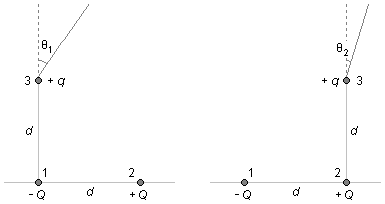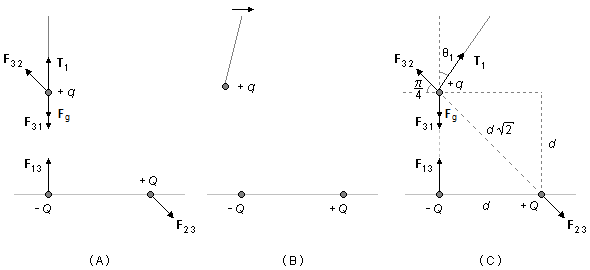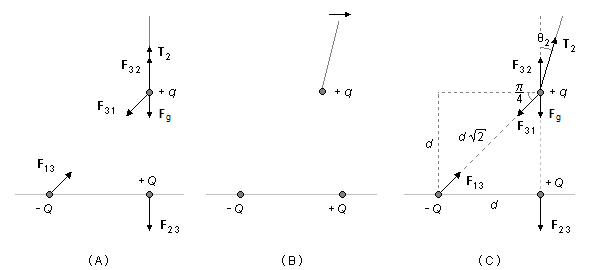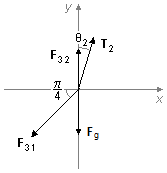Solved Problem on Coulomb's Law
advertisement
Two charges of the same magnitude and opposite signs are fixed on a horizontal line at a distance d from each other. A sphere, with mass m carries an electric charge, attached to a wire and is approximate, first of one of the charges until it is in equilibrium exactly on it at a height d. Then, the wire is moved toward the second charge until the charge is in equilibrium over the second charge. Determine the angles of deviation in both cases, knowing that in the first case, the deviation angle is twice higher than the deviation angle in the second case.
Problem data:
- Distance between the charges horizontally: d;
- Distance between the charges vertically: d;
- Mass of the sphere: m;
- Relationship between the deviation angles: θ1 = 2θ2.
We assume that the fixed charges, 1 and 2 in Figure 1, have values −Q and +Q and the charge on the wire has +q (charge 3).

In equilibrium, we have a distance d between fixed horizontal charges, and the suspended charge is at a vertical distance d. The angle θ1 is twice as θ2, problem data.
Solution:
Initially, the charge +q is approximate to the first charge −Q vertically. On the charge +q will be acting the gravitational force Fg, the tension force T1, the Coulomb force of attraction between +q and −Q, F31, and the Coulomb force of repulsion between +q and +Q, F32 (Figure 2-A). The forces in the vertical are balanced, leaving only the horizontal component of the repulsion force F32 to draw the charge +q from the equilibrium position.To restore equilibrium, it must be moved to the right (Figure 2-B) until it is vertically above the charge −Q. At this instant, the wire attached to the charge +q makes an angle θ1 with the vertical (Figure 2-C).

The force between the charges +q and −Q, F31, acts along the square side that measures d. According to Coulomb's Law, the magnitude of this force will be
\[
\begin{gather}
\bbox[#99CCFF,10px]
{F_{el}=\frac{1}{4\pi\varepsilon_0}\frac{|q_{\small A}||q_{\small B}|}{r^2}}
\end{gather}
\]
\[
\begin{gather}
F_{31}=\frac{1}{4\pi\varepsilon_0}\frac{|q_3||q_1|}{r^2}\\[5pt]
F_{31}=\frac{1}{4\pi\varepsilon_0}\frac{|q||-Q|}{d^2}\\[5pt]
F_{31}=\frac{1}{4\pi\varepsilon_0}\frac{qQ}{d^2} \tag{I}
\end{gather}
\]
The force between the charges +q and +Q, F32, acts along the diagonal of a
square with side length d, formed by the distance between the charges +Q and −Q
and the height of the charge +q. The diagonal has a length
\( d\sqrt{2\;} \),
and this force makes an angle
\( \frac{\pi}{4} \)
with the horizontal, and the magnitude will be
\[
\begin{gather}
F_{32}=\frac{1}{4\pi\varepsilon_0}\frac{|q_3||q_2|}{r^2}\\[5pt]
F_{32}=\frac{1}{4\pi\varepsilon_0}\frac{|q||Q|}{\left(d\sqrt{2\;}\right)^2}\\[5pt]
F_{32}=\frac{1}{4\pi\varepsilon_0}\frac{qQ}{2d^2} \tag{II}
\end{gather}
\]
As the sphere is in equilibrium, the sum of the forces that act on it is equal to zero
\[
\begin{gather}
\bbox[#99CCFF,10px]
{\sum \mathbf F=0}
\end{gather}
\]
applying this condition to the first case (Figure 3)
\[
\begin{gather}
\mathbf F_{32}+\mathbf T_1+\mathbf F_{31}+\mathbf P=0
\end{gather}
\]

where
\( \mathbf F_{32}=-F_{32}\cos\dfrac{\pi}{4}\;\mathbf i+F_{32}\sin\dfrac{\pi}{4}\;\mathbf j \)
\( \mathbf T_1=T_1\sin\theta_1\;\mathbf i+T_1\cos\theta_1\;\mathbf j \)
\( \mathbf F_{31}=-F_{31}\;\mathbf j \)
\( \mathbf P=-mg\;\mathbf j \)
substituting the equaions (I) and (II)
\[
\begin{gather}
-F_{32}\cos\frac{\pi}{4}\;\mathbf i+F_{32}\sin\frac{\pi}{4}\;\mathbf j+T_1\sin\theta_1\;\mathbf i+T_1\cos\theta_1\;\mathbf j-F_{31}\;\mathbf j-mg\;\mathbf j=0\\[5pt]
-{\frac{1}{4\pi\varepsilon_0}\frac{qQ}{2d^2}\frac{\sqrt{2\;}}{2}}\;\mathbf i+\frac{1}{4\pi\varepsilon_0}\frac{qQ}{2d^2}\frac{\sqrt{2\;}}{2}\;\mathbf j+T_1\sin\theta_1\;\mathbf i+T_1\cos\theta_1\;\mathbf j-\frac{1}{4\pi\varepsilon_0}\frac{qQ}{d^2}\;\mathbf j-mg\;\mathbf j=0
\end{gather}
\]
separating the components
- Direction i:
\[
\begin{gather}
-{\frac{1}{4\pi\varepsilon_0}\frac{qQ}{2d^2}\frac{\sqrt{2\;}}{2}}+T_1\sin\theta_1=0\\[5pt]
T_1\sin\theta_1=\frac{1}{4\pi\varepsilon_0}\frac{qQ}{d^2}\frac{\sqrt{2\;}}{4} \tag{III}
\end{gather}
\]
- Direction j:
\[
\begin{gather}
\frac{1}{4\pi\varepsilon_0}\frac{qQ}{2d^2}\frac{\sqrt{2\;}}{2}+T_1\cos\theta_1-\frac{1}{4\pi\varepsilon_0}\frac{qQ}{d^2}-mg=0\\[5pt]
T_1\cos\theta_1=\frac{1}{4\pi\varepsilon_0}\frac{qQ}{d^2}-\frac{1}{4\pi\varepsilon_0}\frac{qQ}{d^2}\frac{\sqrt{2\;}}{4}+mg\\[5pt]
T_1\cos\theta_1=\frac{1}{4\pi\varepsilon_0}\frac{qQ}{d^2}\left(1-\frac{\sqrt{2\;}}{4}\right)+mg \tag{IV}
\end{gather}
\]
In the same way, in the second case, the charge +q is approximate to the second charge +Q
vertically. On the charge +q will be acting the gravitational force Fg, the
tension force, T2, the Coulomb force of attraction between +q and
−Q, F31, and the Coulomb force of repulsion between +q and +Q,
F32 (Figure 4-A). The forces in the vertical are balanced, leaving only the horizontal
component of the attraction force F31 to draw the charge +q from the equilibrium
position. To restore equilibrium, it must be moved to the right (Figure 4-B) until it is vertically above the
charge +Q. At this instant, the wire attached to the charge +q makes an angle
θ2 with the vertical (Figure 4-C).

The force between the charges +q and −Q, F31. acts along the diagonal of the square. According to Coulomb's Law, the magnitude of this force will be
\[
\begin{gather}
F_{31}=\frac{1}{4\pi\varepsilon_0}\frac{|q_3||q_1|}{r^2}\\[5pt]
F_{31}=\frac{1}{4\pi\varepsilon_0}\frac{|q||-Q|}{\left(d\sqrt{2\;}\right)^2}\\[5pt]
F_{31}=\frac{1}{4\pi\varepsilon_0}\frac{qQ}{2d^2} \tag{V}
\end{gather}
\]
The force between the charges +q and +Q, F32, will be
\[
\begin{gather}
F_{32}=\frac{1}{4\pi\varepsilon_0}\frac{|q_3||q_2|}{r^2}\\[5pt]
F_{32}=\frac{1}{4\pi\varepsilon_0}\frac{|q||Q|}{d^2}\\[5pt]
F_{32}=\frac{1}{4\pi\varepsilon_0}\frac{qQ}{d^2} \tag{VI}
\end{gather}
\]
As the sphere is in equilibrium the sum of the forces that act on it is equal to zero,
applying this condition to the second case (Figure 5)
\( \mathbf F_{32}=F_{32}\;\mathbf j \)
\( \mathbf T_2=T_2\sin\theta_2\;\mathbf i+T_2\cos\theta_2\;\mathbf j \)
\( \mathbf F_{31}=-F_{31}\cos\dfrac{\pi}{4}\;\mathbf i-F_{31}\sin\dfrac{\pi}{4}\;\mathbf j \)
\( \mathbf P=-mg\;\mathbf j \)
\[
\begin{gather}
\mathbf F_{32}+\mathbf T_1+\mathbf F_{31}+\mathbf P=0
\end{gather}
\]
where
\( \mathbf F_{32}=F_{32}\;\mathbf j \)
\( \mathbf T_2=T_2\sin\theta_2\;\mathbf i+T_2\cos\theta_2\;\mathbf j \)
\( \mathbf F_{31}=-F_{31}\cos\dfrac{\pi}{4}\;\mathbf i-F_{31}\sin\dfrac{\pi}{4}\;\mathbf j \)
\( \mathbf P=-mg\;\mathbf j \)

substituting the equations (V) and (VI)
\[
\begin{gather}
F_{32}\;\mathbf j+T_2\sin\theta_2\;\mathbf i+T_2\cos\theta_2\;\mathbf j-F_{31}\cos\frac{\pi}{4}\;\mathbf i+F_{31}\sin\frac{\pi}{4}\;\mathbf j-mg\;\mathbf j=0\\[5pt]
\frac{1}{4\pi\varepsilon_0}\frac{qQ}{d^2}\;\mathbf j+T_2\sin\theta_2\;\mathbf i+T_2\cos\theta_2\;\mathbf j-\frac{1}{4\pi\varepsilon_0}\frac{qQ}{2d^2}\frac{\sqrt{2\;}}{2}\;\mathbf i-\frac{1}{4\pi\varepsilon_0}\frac{qQ}{2d^2}\frac{\sqrt{2\;}}{2}\;\mathbf j-mg\;\mathbf j=0
\end{gather}
\]
separating the components
- Direction i:
\[
\begin{gather}
-{\frac{1}{4\pi\varepsilon_0}\frac{qQ}{2d^2}\frac{\sqrt{2\;}}{2}}+T_2\sin\theta_2=0\\[5pt]
T_2\sin\theta_2=\frac{1}{4\pi\varepsilon_0}\frac{qQ}{d^2}\frac{\sqrt{2\;}}{4} \tag{VII}
\end{gather}
\]
- Direction j:
\[
\begin{gather}
\frac{1}{4\pi\varepsilon_0}\frac{qQ}{d^2}+T_2\cos\theta_2-\frac{1}{4\pi\varepsilon_0}\frac{qQ}{2d^2}\frac{\sqrt{2\;}}{2}-mg=0\\[5pt]
T_2\cos\theta_2=\frac{1}{4\pi\varepsilon_0}\frac{qQ}{d^2}\frac{\sqrt{2\;}}{4}-\frac{1}{4\pi\varepsilon_0}\frac{qQ}{d^2}+mg\\[5pt]
T_2\cos\theta_2=\frac{1}{4\pi\varepsilon_0}\frac{qQ}{d^2}\left(\frac{\sqrt{2\;}}{4}-1\right)+mg \tag{VIII}
\end{gather}
\]
Dividing the equation (IV) by (III)
\[
\begin{gather}
\frac{T_1\cos\theta_1}{T_1\sin\theta_1}=\frac{\dfrac{1}{4\pi\varepsilon_0}\dfrac{qQ}{d^2}\left(1-\dfrac{\sqrt{2\;}}{4}\right)+mg}{\dfrac{1}{4\pi\varepsilon_0}\dfrac{qQ}{d^2}\dfrac{\sqrt{2\;}}{4}}\\[5pt]
\frac{1}{\tan\theta_1}=\frac{\cancel{\dfrac{1}{4\pi\varepsilon_0}}\cancel{\dfrac{qQ}{d^2}}\left(1-\dfrac{\sqrt{2\;}}{4}\right)}{\cancel{\dfrac{1}{4\pi\varepsilon_0}}\cancel{\dfrac{qQ}{d^2}}\dfrac{\sqrt{2\;}}{4}}+\frac{mg}{\dfrac{1}{4\pi\varepsilon_0}\dfrac{qQ}{d^2}\dfrac{\sqrt{2\;}}{4}}\\[5pt]
\frac{1}{\tan\theta_1}=\left(1-\frac{\sqrt{2\;}}{4}\right)\frac{4}{\sqrt{2\;}}+\frac{mg}{\dfrac{1}{4\pi\varepsilon_0}\dfrac{qQ}{d^2}\dfrac{\sqrt{2\;}}{4}}\\[5pt]
\frac{1}{\tan\theta_1}=\left(\frac{4}{\sqrt{2\;}}-\frac{\cancel{\sqrt{2\;}}}{\cancel{4}}\frac{\cancel{4}}{\cancel{\sqrt{2\;}}}\right)+\frac{mg}{\dfrac{1}{4\pi\varepsilon_0}\dfrac{qQ}{d^2}\dfrac{\sqrt{2\;}}{4}}\\[5pt]
\frac{1}{\tan\theta_1}=\left(\frac{4}{\sqrt{2\;}}\frac{\sqrt{2\;}}{\sqrt{2\;}}-1\right)+\frac{mg}{\dfrac{1}{4\pi\varepsilon_0}\dfrac{qQ}{d^2}\dfrac{\sqrt{2\;}}{4}}\\[5pt]
\frac{1}{\tan\theta_1}=\left(\frac{4\sqrt{2\;}}{2}-1\right)+\frac{mg}{\dfrac{1}{4\pi\varepsilon_0}\dfrac{qQ}{d^2}\dfrac{\sqrt{2\;}}{4}}\\[5pt]
\frac{mg}{\dfrac{1}{4\pi\varepsilon_0}\dfrac{qQ}{d^2}\dfrac{\sqrt{2\;}}{4}}=\left(2\sqrt{2\;}-1\right)-\frac{1}{\tan\theta_1} \tag{IX}
\end{gather}
\]
Dividing the equation (VIII) by (VII)
\[
\begin{gather}
\frac{T_2\cos\theta_2}{T_2\sin\theta_2}=\frac{\dfrac{1}{4\pi\varepsilon_0}\dfrac{qQ}{d^2}\left(\dfrac{\sqrt{2\;}}{4}-1\right)+mg}{\dfrac{1}{4\pi\varepsilon_0}\dfrac{qQ}{d^2}\dfrac{\sqrt{2\;}}{4}}\\[5pt]
\frac{1}{\tan\theta_2}=\frac{\cancel{\dfrac{1}{4\pi\varepsilon_0}}\cancel{\dfrac{qQ}{d^2}}\left(\dfrac{\sqrt{2\;}}{4}-1\right)}{\cancel{\dfrac{1}{4\pi\varepsilon_0}}\cancel{\dfrac{qQ}{d^2}}\dfrac{\sqrt{2\;}}{4}}+\frac{mg}{\dfrac{1}{4\pi\varepsilon_0}\dfrac{qQ}{d^2}\dfrac{\sqrt{2\;}}{4}}\\[5pt]
\frac{1}{\tan\theta_2}=\left(\frac{\sqrt{2\;}}{4}-1\right)\frac{4}{\sqrt{2\;}}+\frac{mg}{\dfrac{1}{4\pi\varepsilon_0}\dfrac{qQ}{d^2}\dfrac{\sqrt{2\;}}{4}}\\[5pt]
\frac{1}{\tan\theta_2}=\left(\frac{\cancel{\sqrt{2\;}}}{\cancel{4}}\frac{\cancel{4}}{\cancel{\sqrt{2\;}}}-\frac{4}{\sqrt{2\;}}\right)+\frac{mg}{\dfrac{1}{4\pi\varepsilon_0}\dfrac{qQ}{d^2}\dfrac{\sqrt{2\;}}{4}}\\[5pt]
\frac{1}{\tan\theta_2}=\left(1-\frac{4}{\sqrt{2\;}}\frac{\sqrt{2\;}}{\sqrt{2\;}}\right)+\frac{mg}{\dfrac{1}{4\pi\varepsilon_0}\dfrac{qQ}{d^2}\dfrac{\sqrt{2\;}}{4}}\\[5pt]
\frac{1}{\tan\theta_2}=\left(1-\frac{4\sqrt{2\;}}{2}\right)+\frac{mg}{\dfrac{1}{4\pi\varepsilon_0}\dfrac{qQ}{d^2}\dfrac{\sqrt{2\;}}{4}}\\[5pt]
\frac{mg}{\dfrac{1}{4\pi\varepsilon_0}\dfrac{qQ}{d^2}\dfrac{\sqrt{2\;}}{4}}=\left(1-2\sqrt{2\;}\right)-\frac{1}{\tan\theta_2} \tag{X}
\end{gather}
\]
Equating (IX) and (X)
\[
\begin{gather}
\left(2\sqrt{2\;}-1\right)-\frac{1}{\tan\theta_1}=\left(1-2\sqrt{2\;}\right)-\frac{1}{\tan\theta_2}\\[5pt]
\frac{1}{\tan\theta_1}-\frac{1}{\tan\theta_2}=\left(2\sqrt{2\;}-1\right)-\left(1-2\sqrt{2\;}\right)\\[5pt]
\frac{1}{\tan\theta_1}-\frac{1}{\tan\theta_2}=2\sqrt{2\;}-1-1+2\sqrt{2\;}\\[5pt]
\frac{1}{\tan\theta_1}-\frac{1}{\tan\theta_2}=4\sqrt{2\;}-2\\[5pt]
\frac{1}{\tan\theta_1}-\frac{1}{\tan\theta_2}=2\left(2\sqrt{2\;}-1\right)
\end{gather}
\]
Substituting the condition given in the problem θ1 = 2θ2
\[
\begin{gather}
\frac{1}{\tan 2\theta_2}-\frac{1}{\tan\theta_2}=2\left(2\sqrt{2\;}-1\right)
\end{gather}
\]
From Trigonometry
\[
\begin{gather}
\tan(a+b)=\frac{\tan a+\tan b}{1-\tan a\tan b}
\end{gather}
\]
if a = b = θ2 we can rewrite
\[
\begin{gather}
\tan 2\theta_2=\frac{2\tan\theta_2}{1-\tan^2\theta_2}
\end{gather}
\]
\[
\begin{gather}
\frac{1}{\dfrac{2\tan\theta_2}{1-\tan^2\theta_2}}-\frac{1}{\tan\theta_2}=2\left(2\sqrt{2\;}-1\right)\\[5pt]
\frac{1-\tan^2\theta_2}{2\tan\theta_2}-\frac{1}{\tan\theta_2}=2\left(2\sqrt{2\;}-1\right)
\end{gather}
\]
multiplying both sides of the equation by 2 tan θ2
\[
\begin{gather}
\qquad \qquad \qquad \frac{1-\tan^2\theta_2}{2\tan\theta_2}-\frac{1}{\tan\theta_2}=2\left(2\sqrt{2\;}-1\right)\qquad (\times\;2\tan\theta_2)\\[5pt]
\frac{1-\tan^2\theta_2}{\cancel{2\tan\theta_2}}\cancel{2\tan\theta_2}-\frac{1}{\cancel{\tan\theta_2}}2\cancel{\tan\theta_2}=2\left(2\sqrt{2\;}-1\right)2\tan\theta_2\\[5pt]
1-\tan^2\theta_2-2=4\left(2\sqrt{2\;}-1\right)\tan\theta_2\\[5pt]
-\tan^2\theta_2-1=4\left(2\sqrt{2\;}-1\right)\tan\theta_2\\[5pt]
\tan^2\theta_2+4\left(2\sqrt{2\;}-1\right)\tan\theta_2+1=0
\end{gather}
\]
changing the variable x = tan θ2, we can rewrite the equation above
\[
\begin{gather}
x^2+4\left(2\sqrt{2\;}-1\right)x+1=0
\end{gather}
\]
Solution of the Quadratic Equation \( x^2+4\left(2\sqrt{2\;}-1\right)x+1=0 \)
\[
\begin{array}{l}
\Delta =\left[4(2\sqrt{2\;}-1)\right]^2-4\times 1\times 1\\
\Delta =16(2\sqrt{2\;}-1)^2-4\\
\Delta=16(8-4\sqrt{2\;}+1)-4\\
\Delta =4(35-16\sqrt{2\;})\\[10pt]
x=\dfrac{-4(2\sqrt{2\;}-1)\pm\sqrt{4(35-16\sqrt{2\;})\;}}{2\times 1}
\end{array}
\]
the two roots of the equation will be
\[
\begin{gather}
x_1=-0.1394
\\ \quad \text{e} \quad \\
x_2=-7.1743
\end{gather}
\]
for x1 we will have θ2 given by
\[
\begin{gather}
\tan\theta_2=-0.1394\\[5pt]
\theta_2=\arctan(-0.1394)
\end{gather}
\]
\[
\begin{gather}
\bbox[#FFCCCC,10px]
{\theta_2=7.94°=7°56'}
\end{gather}
\]
from the condition of the problem we have for θ1
\[
\begin{gather}
\theta_1=2\times 7.94
\end{gather}
\]
\[
\begin{gather}
\bbox[#FFCCCC,10px]
{\theta_1=15.88°=15°52'}
\end{gather}
\]
for x2 we will have θ2 given by
\[
\begin{gather}
\tan\theta_2=-7.1743\\[5pt]
\theta_2=\arctan(-7.1743)
\end{gather}
\]
\[
\begin{gather}
\bbox[#FFCCCC,10px]
{\theta_2=82.06°=82°03'}
\end{gather}
\]
from the condition of the problem, we have θ1
\[
\begin{gather}
\theta_1=2\times 82.06
\end{gather}
\]
\[
\begin{gather}
\bbox[#FFCCCC,10px]
{\theta_1=164.12°=164°04'}
\end{gather}
\]
advertisement

Fisicaexe - Physics Solved Problems by Elcio Brandani Mondadori is licensed under a Creative Commons Attribution-NonCommercial-ShareAlike 4.0 International License .